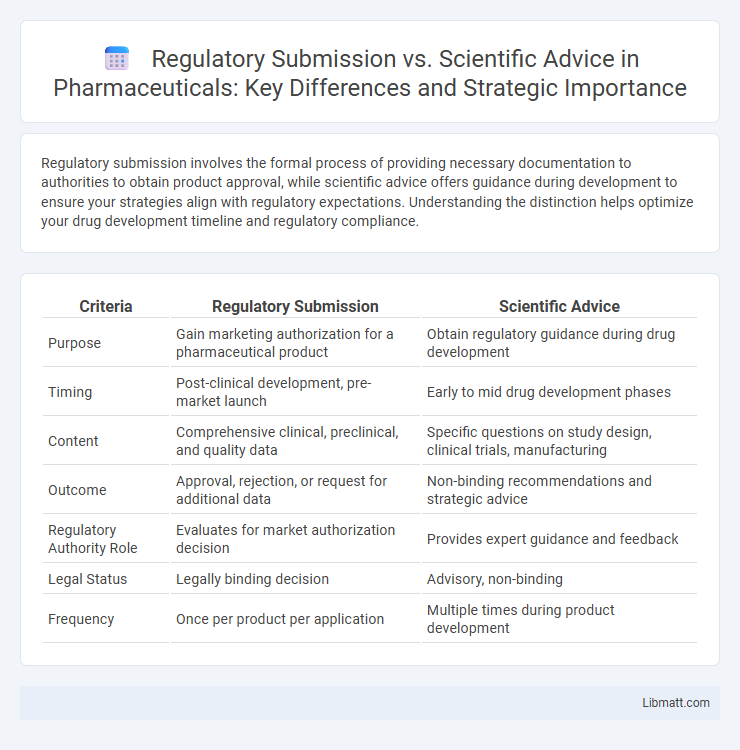Regulatory submission involves the formal process of providing necessary documentation to authorities to obtain product approval, while scientific advice offers guidance during development to ensure your strategies align with regulatory expectations. Understanding the distinction helps optimize your drug development timeline and regulatory compliance.
Table of Comparison
| Criteria | Regulatory Submission | Scientific Advice |
|---|---|---|
| Purpose | Gain marketing authorization for a pharmaceutical product | Obtain regulatory guidance during drug development |
| Timing | Post-clinical development, pre-market launch | Early to mid drug development phases |
| Content | Comprehensive clinical, preclinical, and quality data | Specific questions on study design, clinical trials, manufacturing |
| Outcome | Approval, rejection, or request for additional data | Non-binding recommendations and strategic advice |
| Regulatory Authority Role | Evaluates for market authorization decision | Provides expert guidance and feedback |
| Legal Status | Legally binding decision | Advisory, non-binding |
| Frequency | Once per product per application | Multiple times during product development |
Introduction to Regulatory Submission and Scientific Advice
Regulatory submission involves the formal process of providing comprehensive data and documentation to health authorities to obtain approval for a pharmaceutical product or medical device. Scientific advice represents a consultative interaction with regulatory agencies, offering guidance on development plans, study protocols, and regulatory requirements to optimize product approval success. Both processes are essential components in drug development, balancing compliance with regulatory standards and scientific validation.
Defining Regulatory Submission
Regulatory submission refers to the formal process of providing necessary documentation and data to health authorities to obtain approval for a drug, medical device, or product. This comprehensive dossier includes clinical trial results, manufacturing details, and safety assessments essential for evaluating product compliance with regulatory standards. Your regulatory submission must be meticulously prepared to ensure a smooth review and timely market authorization.
Understanding Scientific Advice
Scientific advice provides early, non-binding guidance from regulatory agencies to help developers design regulatory submissions effectively. It focuses on aligning study designs, data requirements, and regulatory expectations before formal submission, minimizing risks of non-compliance or delays. Your strategic use of scientific advice can optimize development pathways and improve the likelihood of a successful regulatory submission.
Key Differences Between Regulatory Submission and Scientific Advice
Regulatory submission involves the formal presentation of data and documents to health authorities for product approval or marketing authorization, emphasizing compliance with regulatory requirements and evidence of safety, efficacy, and quality. Scientific advice is a proactive consultation process between sponsors and regulatory agencies aimed at obtaining guidance on study design, development strategies, and regulatory expectations to optimize the product development pathway. Key differences lie in regulatory submission being a decisive step toward approval, while scientific advice serves as a collaborative, non-binding interaction to inform future submissions.
Purpose and Objectives of Regulatory Submissions
Regulatory submissions are formal documents submitted to health authorities to obtain approval for marketing drugs, ensuring compliance with safety, efficacy, and quality standards. Their primary purpose is to provide comprehensive evidence supporting the approval of a new drug or product, enabling legal distribution and use in specific markets. Scientific advice, by contrast, offers guidance during drug development to optimize study design and regulatory strategy, but does not seek immediate approval for Your product.
Role and Significance of Scientific Advice in Drug Development
Scientific advice plays a critical role in drug development by providing early, strategic guidance on study design, regulatory expectations, and data requirements, which helps optimize clinical trial protocols and regulatory submission processes. Engaging with regulatory agencies through scientific advice ensures alignment with current standards, reduces the risk of costly delays, and improves the likelihood of successful approval. This proactive consultation supports informed decision-making and efficient resource allocation throughout the drug development lifecycle.
Regulatory Agencies Involved in Submissions and Advice
Regulatory submissions primarily involve agencies such as the FDA (Food and Drug Administration) in the United States, EMA (European Medicines Agency) in Europe, and PMDA (Pharmaceuticals and Medical Devices Agency) in Japan, which review and approve marketing applications for drugs and medical devices. Scientific advice, offered by these agencies, provides early guidance on development plans, study protocols, and regulatory requirements to optimize future submissions. Engagement with regulatory bodies during the scientific advice phase improves alignment on key technical and clinical issues, accelerating product approval timelines.
Timing and Process of Regulatory Submissions vs. Scientific Advice
Regulatory submissions are formal applications submitted to regulatory authorities after completing clinical trials, aiming to obtain marketing authorization; they follow a defined timeline that coincides with the end of product development phases. Scientific advice is sought earlier in the development process, providing confidential guidance on study design and regulatory requirements to optimize future submissions and reduce review risks. The scientific advice process is iterative and flexible, while regulatory submissions adhere to strict procedural deadlines and documentation standards.
Benefits and Challenges of Seeking Scientific Advice
Seeking scientific advice provides early regulatory guidance that can optimize clinical development plans and enhance the quality of regulatory submissions, potentially accelerating approval timelines. Benefits include tailored feedback on study design, data requirements, and regulatory expectations, which reduce the risk of costly trial amendments or submission rejections. Challenges encompass navigating varying agency procedures, managing timelines for advice delivery, and interpreting sometimes non-binding or evolving recommendations.
Strategic Considerations: Integrating Scientific Advice Into Regulatory Submissions
Integrating scientific advice into regulatory submissions enhances strategic decision-making by aligning development plans with regulatory expectations, thereby reducing the risk of approval delays. Leveraging early scientific advice supports adaptive study designs and tailored data packages, optimizing resource allocation and improving the likelihood of successful authorization. Effective incorporation of scientific guidance ensures regulatory submissions are robust, scientifically sound, and responsive to evolving regulatory frameworks.
Regulatory submission vs scientific advice Infographic

 libmatt.com
libmatt.com